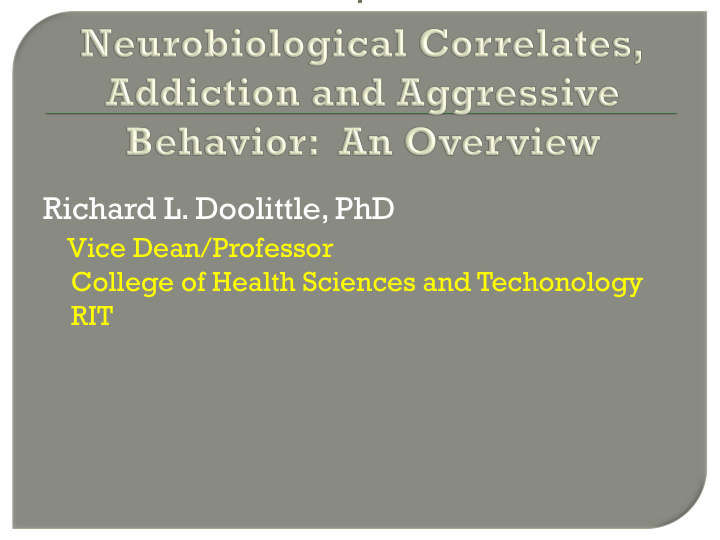



Richard L. Doolittle, PhD Vice Dean/Professor College of Health Sciences and Techonology RIT
“Like so many addicts, I'd thought that if I could only sort out my life, I could then sort out my drinking. It was a revelation to see that it would be simpler the other way around” - Pete Townsend
“A person who drinks too much on occasion is still the same person as when sober. An alcoholic, a real alcoholic, is not the same person at all. You can't predict anything about them for sure except that they will be someone you never met before.” - Raymond Chandler
NIAAA stats: - >51% of those >12 y.o. (120 mill) using; of those, 7.7% (18 mill) met criteria for substance abuser - > 100,000 people die each year due to alcohol-related causes - >$180 Million in cost
Risk of alcoholism = genetic predisposition + environmental influences
Based on: • Extended pedigree studies 4-7 fold increase in first-degree relatives • Twin studies Higher rate in identical vs dizygotic twins • Study of adopted children raised separately from alcoholic parents Higher rate in this population • Gene discoveries?
Benefits of genome discovery: • Identify those at risk • Better understanding of environmental factors • Could lead to better treatments/prevention Animal studies reveal multiple genes responsible for vulnerability to alcoholism – no single gene identified
Many investigators have stressed the importance of the interaction between an inherited biological vulnerability and environmental risk factors for developing alcohol use disorders
Balance of EXCITATORY and INHIBITORY neuronal influences GABA
Imbalance of excitatory/inhibitory NT influences that impact behavioral change
Binge-Intoxication: Positive reinforcement from consumption Withdrawal, Negative Effect: Shift from positive reinforcement to negative reinforcement = desire to avoid negative consequences of withdrawal – change from impulsive to compulsive Preoccupation-Anticipation: Craving and compulsive alcohol seeking
Binge-Intoxication Activation of Mesolimbic Reward Pathway - Increase in dopamine – “feel good” neurotransmitter; disinhibition (engaged in all aspects of dependency?)* - Increase natural opioids * George Koob, 2010
The pathway begins in the ventral tegmental area (VTA) of the midbrain and connects to the limbic system via the nucleus accumbens, the amygdala, and the hippocampus, as well as to the medial prefrontal cortex
Engaged with “natural rewards”of life = seeking food/water/reproduction
Withdrawal, Negative Effect Due to alcohol-induced neuro-adaptation/ neuroplasticity changes Accompanied by decrease in dopamine levels, decrease in serotonin levels, increase in GABA influences (inhibitory) + Activation of HPA axis - CRF release (stress)
Withdrawal, Negative Effect Move from impulsive to compulsive behavior around alcohol use Preoccupation, Anticipation, Craving Continued down-regulation of NT with neuroplasticity changes;maximum CRF/ stress response (anxiety, agitation, panic, impulsivity, etc.)
“It is most absurdly said, in popular language, of any man, that he is disguised in liquor; for, on the contrary, most men are disguised by sobriety” Thomas de Quincy, Confessions of an English Opium-Eater (1856)
Stronger relationship between alcohol consumption and aggression in subjects with certain traits: • Antisocial personality • Alcohol dependency • Impaired cognitive function • Previous aggressive episodes Still difficult to predict
Valerie Altounian , RIT Medical Illustration student (now employed by American Assosiation for Advancement of SCIENCE Journal)
Recommend
More recommend